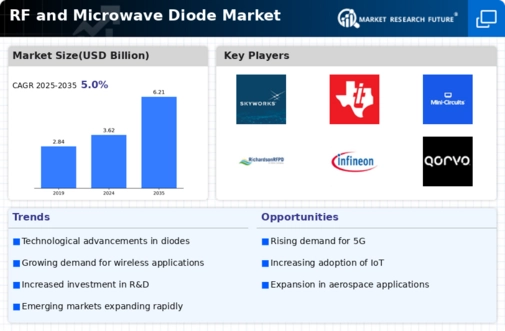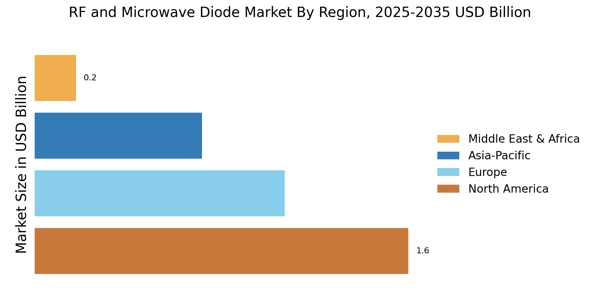Growth in Automotive Electronics
The growth in automotive electronics is emerging as a significant driver for the RF and Microwave Diode Market. With the automotive sector increasingly adopting advanced technologies such as radar-based safety systems, vehicle-to-everything (V2X) communication, and infotainment systems, the demand for RF and microwave diodes is likely to surge. These diodes are critical for enabling high-frequency communication and signal processing in modern vehicles. Industry forecasts suggest that the automotive electronics market will witness a CAGR of approximately 8% over the next few years, which could translate into substantial opportunities for diode manufacturers catering to this evolving sector.
Emerging Applications in Medical Devices
Emerging applications in medical devices are poised to drive growth in the RF and Microwave Diode Market. The healthcare sector is increasingly utilizing RF and microwave technologies for diagnostic imaging, therapeutic applications, and wireless health monitoring systems. Diodes are essential components in these devices, facilitating accurate signal transmission and processing. As the demand for non-invasive medical procedures and remote patient monitoring rises, the market for RF and microwave diodes is expected to expand. Reports indicate that the medical device market is projected to grow at a CAGR of around 7% in the coming years, suggesting a favorable environment for diode manufacturers targeting this sector.
Rising Demand for Wireless Communication
The increasing demand for wireless communication technologies is a primary driver of the RF and Microwave Diode Market. As mobile devices proliferate and the Internet of Things (IoT) expands, the need for efficient and reliable communication systems intensifies. RF and microwave diodes play a crucial role in enabling high-frequency signal transmission, which is essential for modern communication networks. According to industry reports, the wireless communication sector is projected to grow at a compound annual growth rate (CAGR) of over 10% in the coming years. This growth is likely to spur investments in RF and microwave technologies, thereby enhancing the market for diodes that support these applications.
Advancements in Radar and Satellite Technologies
Advancements in radar and satellite technologies are significantly influencing the RF and Microwave Diode Market. The demand for sophisticated radar systems in defense, aviation, and meteorology is on the rise, necessitating the use of high-performance diodes. These diodes are integral to the functionality of radar systems, enabling precise signal processing and detection capabilities. Furthermore, the satellite communication sector is experiencing a renaissance, with new satellite launches and upgrades to existing systems. This trend is expected to drive the market for RF and microwave diodes, as they are essential components in satellite transponders and ground stations, facilitating efficient data transmission and reception.
Increased Investment in Telecommunications Infrastructure
Increased investment in telecommunications infrastructure is a critical driver of the RF and Microwave Diode Market. Governments and private entities are investing heavily in upgrading and expanding communication networks to meet the growing demand for high-speed internet and mobile connectivity. This investment is likely to enhance the deployment of RF and microwave technologies, which are essential for the operation of modern telecommunications systems. As 5G networks continue to roll out, the need for high-performance diodes that can operate at higher frequencies becomes paramount. Analysts predict that the telecommunications infrastructure market will experience robust growth, further propelling the demand for RF and microwave diodes.
















Leave a Comment